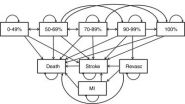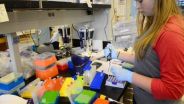(Press-News.org) OAK BROOK, Ill. – Imaging can be a cost-effective way to identify people at risk for stroke who might benefit from aggressive intervention, according to a new modeling study published online in the journal Radiology.
The study looked at people with asymptomatic carotid artery stenosis, a narrowing of the major blood vessels supplying blood to the head due to atherosclerosis, or plaque buildup. Carotid artery stenosis is the primary cause of up to 20 percent of ischemic strokes, which result from an obstruction within a blood vessel and make up 85 percent of all strokes. Stroke victims often undergo revascularization procedures like carotid endarterectomy, or surgical removal of the plaque, to restore blood flow, but use of the procedures in asymptomatic patients is more controversial, according to Ankur Pandya, Ph.D., assistant professor of healthcare policy and research and public health in radiology at Weill Cornell Medical College in New York City.
"There are complications and costs associated with these revascularization procedures, and they are often done without knowing if the risks and costs are worth the benefits," Dr. Pandya said.
Dr. Pandya and colleagues recently assessed the impact of cerebrovascular reserve (CVR) testing, a measure of blood flow reserve to the brain, on asymptomatic people with significant carotid artery stenosis. While different imaging modalities can be used in CVR testing, the researchers used transcranial Doppler (TCD) sonography, an inexpensive, widely available option that does not expose patients to ionizing radiation. They constructed a mathematical model that allowed them to make hypothetical comparisons among three different approaches: CVR testing, immediate revascularization with carotid endarterectomy, and medical therapy-based management with subsequent revascularization only for patients whose stenosis got worse.
The CVR-based approach, which led to about half of the patients receiving revascularization, appeared to have the most favorable balance of benefits and costs. The medical therapy-based strategy was associated with the lowest lifetime costs and the fewest revascularizations; however, it also resulted in the lowest life expectancy and lifetime quality-adjusted years, which account for both the length and quality of life experienced by patients. The immediate revascularization strategy had the highest costs, by a wide margin, and only incremental health benefits compared with the CVR-based approach.
"The study results show that imaging can be a cost-effective tool to stratify patients by risk of stroke and help sort patients into invasive, expensive interventions and less invasive options," Dr. Pandya said.
Dr. Pandya said that CVR testing also has the potential to help characterize whether carotid artery plaque is causing abnormal brain blood flow patterns which may, therefore, identify the patients who are at greatest risk of stroke.
"CVR testing with ultrasound could be used to stratify patients by risk based on abnormal blood flow patterns to the brain, and then other imaging tests like MRI could be employed to look at the composition and stability of plaque, which may give greater insight into those plaques most likely to rupture and cause symptoms" Dr. Pandya said.
Cost-effectiveness models like the one used in the study have gained prominence is recent years and are already used by healthcare payers in Europe, Canada and Australia. Dr. Pandya expects these models to become more prominent in the United States as healthcare reform evolves.
"Our model takes all these pieces of information on risks, costs and benefits and does the math in a systematic way to help clinicians make decisions," he said.
An estimated 400,000 patients over the age of 70 years in the United States have asymptomatic carotid artery stenosis, putting them at a higher risk of stroke.
INFORMATION:
"Carotid Artery Stenosis: Cost-effectiveness of Assessment of Cerebrovascular Reserve to Guide Treatment of Asymptomatic Patients." Collaborating with Dr. Pandya at Weill Cornell Medical College were Ajay Gupta, M.D., Hooman Kamel, M.D., Babak B. Navi, M.D., Pina C. Sanelli, M.D., M.P.H., and Bruce R. Schackman, Ph.D.
Radiology is edited by Herbert Y. Kressel, M.D., Harvard Medical School, Boston, Mass., and owned and published by the Radiological Society of North America, Inc.
RSNA is an association of more than 53,000 radiologists, radiation oncologists, medical physicists and related scientists promoting excellence in patient care and health care delivery through education, research and technologic innovation. The Society is based in Oak Brook, Ill. (RSNA.org)
For patient-friendly information on stroke, visit RadiologyInfo.org.
Imaging identifies asymptomatic people at risk for stroke
2014-09-16
ELSE PRESS RELEASES FROM THIS DATE:
Researchers debunk myth about Parkinson's disease
2014-09-16
Using advanced computer models, neuroscience researchers at the University of Copenhagen have gained new knowledge about the complex processes that cause Parkinson's disease. The findings have recently been published in the prestigious Journal of Neuroscience.
The defining symptoms of Parkinson's disease are slow movements, muscular stiffness and shaking. There is currently no cure for the condition, so it is essential to conduct innovative research with the potential to shed some light on this terrible disruption to the central nervous system. Using advanced computer ...
Dental and nutrition experts call for radical rethink on free sugars intake
2014-09-16
Sugars in the diet should make up no more than 3% of total energy intake to reduce the significant financial and social burdens of tooth decay, finds new research from UCL (University College London) and the London School of Hygiene & Tropical Medicine.
The study, published in the open-access journal BMC Public Health, analysed the effect of sugars on dental caries, also known as tooth decay. They show that sugars are the only cause of tooth decay in children and adults.
Free sugars are defined by the World Health Organisation Nutrition Guidance Adivisory Group as follows: ...
Collaboration drives achievement in protein structure research
2014-09-15
When this week's print issue of the journal Science comes out, a collective cheer will go up from New Mexico, Montana and even the Netherlands, thanks to the type of collaborative effort that is more and more the norm in these connected times. Yes, the research was brilliant, and if we're lucky, it will produce innovations in biology, medicine, biotechnology and agriculture. It could save lives, and it happened because this scientist talked with that one, that one knew another one, and brilliant minds overcame geographic distance to advance human understanding.
"It is ...
Certain form of baldness at age 45 linked to higher risk of aggressive prostate cancer
2014-09-15
A new, large cohort analysis from the prospective Prostate, Lung, Colorectal and Ovarian (PLCO) Cancer Screening Trial, indicates that men who had moderate baldness affecting both the front and the crown of their head at age 45 were at a 40% increased risk of developing aggressive prostate cancer (usually indicates a faster growing tumor resulting in poorer prognosis relative to non-aggressive prostate cancer) later in life, compared to men with no baldness. There was no significant link between other patterns of baldness and prostate cancer risk. The study, published September ...
Researcher develops and proves effectiveness of new drug for spinal muscular atrophy
2014-09-15
COLUMBIA, Mo. – According to recent studies, approximately one out of every 40 individuals in the United States is a carrier of the gene responsible for spinal muscular atrophy (SMA), a neurodegenerative disease that causes muscles to weaken over time. Now, researchers at the University of Missouri have made a recent breakthrough with the development of a new compound found to be highly effective in animal models of the disease. In April, a patent was filed for the compound for use in SMA.
"The strategy our lab is using to fight SMA is to 'repress the repressor,'" said ...
EEG study findings reveal how fear is processed in the brain
2014-09-15
DALLAS, TX – September 12, 2014 - An estimated 8% of Americans will suffer from post traumatic stress disorder (PTSD) at some point during their lifetime. Brought on by an overwhelming or stressful event or events, PTSD is the result of altered chemistry and physiology of the brain. Understanding how threat is processed in a normal brain versus one altered by PTSD is essential to developing effective interventions.
New research from the Center for BrainHealth at The University of Texas at Dallas published online today in Brain and Cognition illustrates how fear arises ...
Smithsonian scientists discover tropical tree microbiome in Panama
2014-09-15
Human skin and gut microbes influence processes from digestion to disease resistance. Despite the fact that tropical forests are the most biodiverse terrestrial ecosystems on the planet, more is known about belly-button bacteria than bacteria on trees in the tropics. Smithsonian scientists and colleagues working on Panama's Barro Colorado Island discovered that small leaf samples from a single tree were home to more than 400 different kinds of bacteria. The combined sample from 57 tree species contained more than 7,000 different kinds.
Bacteria in tropical forests may ...
Scientists discover RNA modifications in some unexpected places
2014-09-15
CAMBRIDGE, Mass. (September 15, 2014) – The so-called central dogma of molecular biology—that DNA makes RNA which makes protein—has long provided a simplified explanation for how genetic information is deciphered and translated in living organisms.
In reality, of course, the process is vastly more complicated than the schema first articulated nearly 60 years ago by Nobel Laureate Francis Crick, co-discoverer of the DNA's double-helix structure. For one, there are multiple types of RNA, three of which—messenger RNA (mRNA), transfer RNA (tRNA), and ribosomal RNA (rRNA)—are ...
Study first to use brain scans to forecast early reading difficulties
2014-09-15
UC San Francisco researchers have used brain scans to predict how young children learn to read, giving clinicians a possible tool to spot children with dyslexia and other reading difficulties before they experience reading challenges.
In the United States, children usually learn to read for the first time in kindergarten and become proficient readers by third grade, according to the authors. In the study, researchers examined brain scans of 38 kindergarteners as they were learning to read formally at school and tracked their white matter development until third grade. ...
'Femme fatale' emerald ash borer decoy lures and kills males
2014-09-15
An international team of researchers has designed decoys that mimic female emerald ash borer beetles and successfully entice male emerald ash borers to land on them in an attempt to mate, only to be electrocuted and killed by high-voltage current.
"Our new decoy and electrocution process may be useful in managing what the U.S. Department of Agriculture Forest Service claims to be the most destructive forest pest ever seen in North America," said Michael Domingue, postdoctoral fellow in entomology, Penn State.
According to the Forest Service, the emerald ash borer was ...





